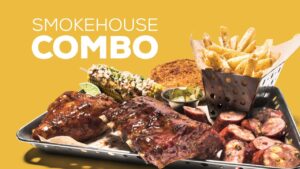Eat and meet
The Global Burden of Disease Study (GBD), a collaboration of more than 2,300 researchers in 133 countries, assessed mortality and disability from 300-plus diseases. Based on these data, collected over a 35-year period, the obesity epidemic is undeniable – more than 2 billion children and adults suffer from health problems related to being overweight or obese.
Clearly, what we eat matters, and it turns out, where we eat also matters. And now, after a long time confined to home, many people are back to embracing restaurant culture and letting someone else do the cooking. As with most things, moderation is key.
Research suggests that most people can eat the same meal for breakfast and lunch with little complaint. To be satisfied, we only need variety in at least one meal per day (usually dinner). This is, in fact, what most people do when they eat at home: They eat the same breakfast and lunch/snack, and try to vary the dinner menu. When we go out to eat, however, we consume food with little regard for its nutritional content; we are more interested in flavors and quantity. This presents a real dilemma for our health!
Typical restaurant meals are loaded
Recent studies show that the average restaurant dinner provides more calories, fats, and sodium than a person requires for an entire day, or up to four days, in some cases.
In one study, the average breakfast, lunch, and dinner meals from 19 sit-down chain food restaurants contained:
- 1,128 calories, or 56% of the average daily 2000-calorie recommendation
- 151% of the sodium amount an adult should consume in a single day
- 89% of the daily value for fat
- 83% of the daily value for saturated fat
- 60% of the daily value for cholesterol
Furthermore, if one orders dessert, it would add approximately 549 more calories, plus 27 g fat, 13 g saturated fat, 0.6 g trans-fat, and 46 g of added sugar.
In another study, researchers analyzed 157 full meals from 33 restaurants. Seventy-three percent of the meals contained more than half the recommended 2,000 calories for the average adult, and 12 meals contained more than a full day’s worth of calories.
Meals with the highest average calorie count included fare categorized as Italian (1,755 calories), American (1,494 calories), and Chinese (1,474 calories) options. Meals with the fewest average calories were from Vietnamese (922 calories) and Japanese (1,027 calories) restaurants. Additionally, local family-run restaurants were just as likely to pile on the calories as the big chain restaurants. Also, it was found that portions and calories-per-ounce varied by a factor of two between restaurants for essentially the same dishes.
What counts as a ‘day’s worth?’
It’s clear that eating out represents a challenge to healthy eating, compared to dining at home, especially if you eat in restaurants several times per week. (Of course, this assumes you take care to prepare and eat healthy foods – but that’s a topic for another article.)
The FDA provides precise daily values (DV) of nutrients for different age groupings. The DVs are often used to judge the adequacy of a meal or a day’s food consumption relative to recommended values. Below, I provide the average recommended nutrient amounts for total daily intake of calories, total fat, saturated fat, sodium, cholesterol, and added sugars. For optimum health, most adults are advised not to exceed these general amounts.
What should be in a day?
- Calories: 2,000
- Total fat (g): 20-35% of your total calories
- Saturated fat (g): 10% of your total calories
- Sodium (mg): 2,300 mg
- Cholesterol (mg): 300 mg
- Added sugars: 50 g
[Note: 2,300 mg = about 1/2 teaspoon. Added sugars include sucrose or dextrose added during processing, foods packaged as sweeteners (table sugar), sugars from syrups and honey, and sugars from concentrated fruit or vegetable juices.]
Outrageous restaurant foods
Below I present six outrageous menu options from well-known restaurants. They may taste good, but they contain ridiculous amounts of calories, fat, sodium, sugar, or saturated fat compared to the recommended DV. Don’t say I didn’t warn you.
Topgolf’s 24 Injectable Donut Holes
This offering from a chain of driving range/sports bars comes with a supply of plastic syringes so you can inject chocolate, raspberry jelly, and/or Bavarian cream into each donut hole.
One serving of this whole meal, disguised as a snack, equals almost a full-day’s worth of calories (1,880), over 2.8-days’ worth of saturated fat (37 g), nearly a full-day’s worth of sodium (1,830 mg), and about 1.6-days’ worth of added sugar (82 g). You can always share a plate with your golfing buddies, but only if they share their orders of Topgolf’s 1,250-calorie tater tots, 1,450-calorie chips & queso, or 1,750-calorie cheese fries.
Jimmy John’s 16-inch Giant Gargantuan Sandwich
“The only thing better than a sandwich, is a sandwich twice the size,” according to Jimmy John’s Twitter account. This gigantic “meal” comes with salami, capicola (cured meats), turkey, roast beef, ham, provolone cheese, onion, lettuce, tomato, mayo, and oil & vinegar.
One Giant Gargantuan equals more than a day’s worth of calories (2,240), more than two-days’ worth of saturated fat (30 g), nearly four-days’ worth of sodium (7,910 mg), and more than 1.5-days’ worth of cholesterol (405 mg).
Sonic’s Oreo Peanut Butter Master Shake
This quart-sized (32 oz.) “large” shake consists of “real ice cream mixed with rich peanut butter and Oreos into a thick and creamy shake, finished with whipped topping and a cherry.” This frozen treat contains slightly less than a day’s worth of calories (1,720), more than 2.3-days’ worth of total fat (104 g), more than two-days’ worth of saturated fat (48 g), a little more than one day’s worth of cholesterol (190 mg), 1,040 mg sodium, and a little more than 2.2-days’ worth of added sugars (111 g).
Chili’s Ultimate Smokehouse Combo
Chili’s advertises this meal as “having more flavor than can fit on a plate,” so it’s served on a tray. You get to choose any three meats, including smoked bone-in BBQ chicken breast, jalapeño-cheddar smoked-sausage, hand-battered Chicken Crispers, or a half-rack of house-smoked baby-back ribs.
But that’s not all. You also get an order of Chicken Crispers (with honey mustard sauce) and the Texas Dry Rub Ribs, plus sides of roasted street corn, homestyle fries, chili-garlic toast, and garlic dill pickles. This ultimate overload provides more than 1.4-days’ worth of calories (2,725), 3.2-days’ worth of sodium (7,460 mg), 3.75-days’ worth of total fat (1,66 g), 1.3-days’ worth of cholesterol (400 mg), and 1.1-days’ worth of added sugars (55 g).
Cheesecake Factory’s Pasta Napoletana
This so-called Italian dish contains sausage, pepperoni, meatballs, and bacon on pasta that’s been drenched with butter and cream. Not surprisingly, this dish contains about 1.5-days’ worth of calories (2,480 kcal), almost five-days’ worth of total fat (221 g), more than 3.5-days’ worth of saturated fat (82g), more than 1.5-days’ worth of cholesterol (415 mg), and about three-days’ worth of sodium.
IHOP Cheeseburger Omelette with Pancakes (3), Butter (1 pad), and Syrup (2 tbsp)
This breakfast meal is advertised as “the kind of meal you can’t get anywhere else, not even at home.” Seriously? This breakfast includes three eggs with hamburger patty pieces, hash browns, tomatoes, onions, American cheese, ketchup, mustard, and pickles. It comes with a side of three buttermilk pancakes (plus 1 pad of butter) and two tablespoons of syrup. This meal comprises almost one full-day’s worth of calories (1,990), more than two-days’ worth of saturated fat (45 g), three-days’ worth of sodium (4,580 mg), 4-days’ worth of cholesterol (1,200 mg), and almost a full-day’s worth of added sugars (44 g).
Recommendations
Restaurant meals often include unexpected calories, and elevated amounts of sodium, fat, cholesterol, and saturated fat. This makes eating out a health challenge. It requires pre-planning and careful attention to detail. Before dining out, check the restaurant’s menu and decide what you’ll order. Most restaurants offer vegetarian, vegan, or “heart-healthy” low-cholesterol, low-sodium options, including salads, vegetable dishes, and lower-fat fish options.
Don’t be afraid to request the chef modify a particular dish by using less oil, butter, and sodium. Avoid creams, large cheese toppings, MSG, and foods that are pickled. Soy and teriyaki sauce are high in sodium, as are broths and au jus (light gravy made using fat drippings from meat – usually roast beef). Moreover, always request that all sauces, salad dressings, or gravy be served on the side. In lieu of a fried entree, request one that is grilled, baked, broiled, steamed, poached, or roasted.Also, to make informed choices, investigate whether the restaurant provides calorie and other nutrition information for most standard menu items. By 2018 the FDA required all food establishments with 20 or more fixed locations doing business under the same name and offering the same menu items to provide calorie and other nutrition information in a clear and consistent manner. This includes quick-service and sit-down restaurants, grocery and convenience stores, food takeout facilities and delivery services, entertainment venues, cafeterias, coffee shops, superstores, and some managed food-service operations. In many instances, these data are provided online, but you may need to request it, since restaurants don’t like to display the information.
Wonder why?
References
- Ahuja, JKC, et al. “A comparison of concentrations of sodium and related nutrients (potassium, total dietary fiber, total and saturated fat, and total sugar) in private-label and national brands of popular, sodium-contributing, commercially packaged foods in the United States.” The Journal of the Academy of Nutrition and Dietetics. 2017;117(5):770-777.
- Ahuja, JKC, et al. “Assessing changes in sodium content of selected popular commercially processed and restaurant foods: Results from the USDA: CDC sentinel foods surveillance program.” Nutrients. 2019;11(8):1754.
- Alexander, E., et al. “Trends in the healthiness of U.S. fast food meals, 2008-2017.” European Journal of Clinical Nutrition. 2021;75(5):775-781.
- Bleich, S.N., et al. “Calorie and nutrient trends in large U.S. chain restaurants, 2012-2018.” PLoS One. 2020;15(2):e0228891.
- Center For Science in the Public Interest
- Du, W., et al. “Sodium content of restaurant dishes in China: a cross-sectional survey.” Nutrition Journal. 2022;21(1):10
- Extreme eating awards
- Grummon. A.H., et al. “Changes in calorie content of menu items at large chain restaurants after implementation of calorie labels.” JAMA Network Open. 2021;4(12):e2141353.
- Hobin, E., et al. “Nutritional quality of food items on fast-food ‘kids’ menus’: comparisons across countries and companies.” Public Health Nutrition. 2014;17(10):2263-9.
- Hua, S.V., et al. “Prevalence and nutrient composition of menu offerings targeted to customers with dietary restrictions at U.S. fast casual and full-service restaurants.” Public Health Nutrition. 2021;24(6):1240-1247.
- Johnson, C.M., et al. “Sodium content of lunchtime fast food purchases at major U.S. chains. Archives of Internal Medicine 2010;170(8):732-734.
- Pereira, M.A., et al. “Fast-food habits, weight gain, and insulin resistance (the CARDIA study): 15-year prospective analysis.” Lancet. 2005;365(9453):36-42.
- Roberts, S.B., et al. “Measured energy content of frequently purchased restaurant meals: Multi-country cross-sectional study.” BMJ. 2018;363:k4864.
- Scourboutakos, M.J., et al. “Restaurant meals: Almost a full day’s worth of calories, fats, and sodium.” JAMAInternal Medicine. 2013;173(14):1373-4.
- Vercammen, K.A., et al. “Calorie and nutrient profile of combination meals at U.S. fast food and fast-casual restaurants.” American Journal of Preventive Medicine. 2019;57(3):e77-e85.










Beverly Trebesch - 1986
Eye opener and back the food truck up!
Reply
Robert Primeau - ‘72 BBA ‘74 MBA
Dining out is part of popular culture, only described as “more, more, more … how do you like it”
Reply
Brenda Gillespie
What should be in a day? NOT 50 g. of added sugar!! You will feel better with no processed sugar. If you crave, try 5-10 g.
Thanks for the rest of the article. Great review (and caution) of restaurant foods!
Reply
Russell Lyons - 1983
You write, “Note: 2,300 g = 1 teaspoon”. That’s denser than anything on earth! Of course, you meant “mg” or meant a period in place of the comma. But it was pretty funny to imagine this.
Reply
Deborah Holdship
We regret the error.
Reply